
The Smithsonian’s National Museum of the American Indian in New York, left, and Washington, D.C.
Submitted photo
As stated in the Kentucky Academic Standards (KAS) for Social Studies, the goal of social studies education is for children to “develop thinking and decision-making skills that prepare them for responsible citizenship in a democratic society.” Hearing from and learning about diverse groups in the Americas is critical to reaching this goal.
The Smithsonian’s National Museum of the American Indian (NMAI) gives teachers and students more complete knowledge and understanding of Native American history, cultures and contemporary issues. A long-term initiative of the museum, Native Knowledge 360° (NK360°) offers teachers tools and support through a Framework for Essential Understandings about American Indians; dynamic classroom materials; and diverse approaches to teacher training and student programming.
Essential Understandings
The NMAI’s Essential Understandings (EUs) about American Indians is a framework organized around 10 themes with key concepts about American Indian histories, cultures and contemporary lives. In contrast to the incomplete stories often told of Pocahontas and Thanksgiving, the EUs give teachers insight into key concepts that reflect a multitude of untold stories, experiences and contributions.
Classroom Materials
While the EUs give teachers an idea of the “what” that can be taught in regard to Native Americans, educators often need a “how.” NK360° classroom materials tell new stories and bring Native voices to the present.
Elementary School
Kentucky elementary students identify and compare diverse groups in the Americas and consider the motivations of people of yesterday, today and long ago. Elementary teachers might consider using the NK360° teaching poster “A Life in Beads: The Stories a Plains Dress Can Tell” to help students understand the importance of past traditions to contemporary Native people, as well reflect on cultural meanings behind dress decoration.
Elementary students also consider how culture influences the ways in which people modify and adapt to their environments. The case studies in “American Indian Responses to Environmental Challenges” highlight how Native communities today use indigenous knowledge and their culture to address changes to their homelands.
Fourth grade students’ study of the migration and settlement of Colonial America presents an opportunity for students to consider early events from Native perspectives through the digital inquiry, “Early Encounters in Native New York: Did Native People Really Sell Manhattan?”
Finally, examining the conflict and compromise that resulted from migration and settlement is an appropriate time to begin a discussion of American Indian Removal, helping students see that removal impacted many Native nations and understand that Native people are still here today.
Middle School
In the middle grades, Kentucky students examine impacts of movement and migration between expanding civilizations. NK360° has two inquiry-based resources on the Inka Empire that focus on innovation and engineering in water management and developing complex road systems. Both inquiries present opportunities for cross-curricular instruction and collaboration, including science and math. By 8th grade, students can take a closer look at the themes of conflict and compromise and return to the Removal inquiry to examine more complex sources and stories.
High School
Students are now able to revisit themes they encountered in earlier grades, but ask more questions and further challenge common assumptions about Native peoples.
- U.S. History: As students explore reasons for and responses to the move from rural to urban spaces, they are ready to construct questions and challenge the false notion of an “open” West. Teachers can utilize elements from the treaty-based inquiries that relate to the topic of westward expansion, as treaties were a tool the United States used to acquire Native lands. As students move through a survey of U.S. history and analyze influences on American life in World War II, teachers could select chapters from “Native Words, Native Warriors” resource to give students insight into the lives and experiences of Native American Code Talkers. Finally, as students investigate competing viewpoints as demographics shift in America, they might turn their attention to how Native communities advocated for their rights and examine the Pacific Northwest Fish Wars inquiry, “What Kinds of Actions Can Lead to Justice?” Teachers might use this inquiry as a case study for ways in which groups take informed action to address long-standing issues.
- Civics: As students work to understand the unique roles of local, state, and national institutions, the museum encourages Kentucky teachers to discuss how tribes interact with state and federal governments. The Fish Wars Inquiry gives teachers an example of the distinctions between state, tribal and federal government, and the role of the courts in mitigating disputes between the parties.
- Geography: Students revisiting the interplay between human systems and the natural environment offers an opportunity to return to the Environmental Challenges resource and engage more critically with the variety of sources and tools on the website.
Teacher Training and Student Programming
NK360° helps build confidence among educators to take risks and be bold in how they build learning experiences. NK360° trainings and student programs use gallery experiences, digital classroom materials, and museum experts to facilitate dynamic professional development.
By teaching the rich diversity, experiences and perspectives of Native Americans, both in the past and today, students will better understand our collective history and be more prepared to act as informed and responsible citizens today.
Colleen Call Smith serves as an education specialist (materials developer) in the National Museum of the American Indian’s Office of Education. She earned her master’s degree in secondary education from the University of Kentucky and taught middle and high school social studies for a number of years in Kentucky, Virginia and Washington, D.C. She supports the education office in the research, development, writing and production of online resources for the Native Knowledge 360° initiative.



Leave A Comment